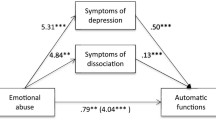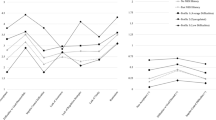Abstract
The purpose of this study was to examine a model of factors that place psychiatrically hospitalized girls at risk for non-suicidal self-injury (NSSI). The role of familial and peer interpersonal difficulties, as well as emotional dysregulation, were examined in relationship to NSSI behaviors. Participants were 99 adolescent girls (83.2% Caucasian; M age = 16.08) admitted to a psychiatric hospital. Structural equation modeling indicated the primacy of emotional dysregulation as an underlying process placing adolescents at risk for NSSI and mediating the influence of interpersonal problems through the family and peer domains. When family and peer relationships were characterized by conflict and lack of support for managing emotions, adolescents reported more dysregulated emotion processes. Family relational problems were directly and indirectly related to NSSI through emotional dysregulation. The indirect processes of peer relational problems, through emotional dysregulation, were significantly associated with NSSI frequency and severity. The findings suggest that the process by which interpersonal difficulties contribute to NSSI is complex, and is at least partially dependent on the nature of the interpersonal problems and emotion processes.



Similar content being viewed by others
References
Achenbach, T. M., & Rescorla, L. A. (2001). Manual for ASEBA School-Age Forms &Profiles. Burlington, VT: University of Vermont, Research Center for Children, Youth, & Families.
Adrian, M., Zeman, J., Erdley, C. A., Lisy, L., Homan, K., & Sim, L. (2009). Social contextual links to emotion regulation in an adolescent psychiatric inpatient population: Do gender and symptomatology matter? Journal of Child Psychology and Psychiatry, 50, 1428–1436.
Barber, B. K. (1996). Parental psychological control: Revisiting a neglected construct. Child Development, 67, 3296–3319.
Bradley, S. J. (2000). Affect regulation and the development of psychopathology. New York: Guilford Press.
Bukowski, W. M., & Hoza, B. (1989). Popularity and friendship: Issues in theory, measurement, and outcome. In T. J. Berndt & G. W. Ladd (Eds.), Peer relationship in child development (pp. 15–45). Oxford: Wiley.
Buhrmester, D., & Furman, W. (1987). The development of companionship and intimacy. Child Development, 58, 1101–1113.
Carson, J. L., & Parke, R. D. (1996). Reciprocal negative affect in parent-child interactions and children’s peer competency. Child Development, 67, 2217–2226.
Cicchetti, D., Ackerman, B. P., & Izard, C. (1995). Emotions and emotion regulation in developmental psychopathology. Development and Psychopathology, 7, 1–10.
Cicchetti, D., & Toth, S. (1998). The development of depression in children and adolescents. American Psychologist, 52, 221–241.
Cohen, S., & Wills, T. A. (1985). Stress, social support, and the buffering hypothesis. Psychological Bulletin, 98, 310–357.
Crick, N. R., & Grotpeter, J. K. (1996). Children's treatment by peers: Victims of relational and overt aggression. Development and Psychopathology, 8, 367–380.
Crowell, S. E., Beauchaine, T. P., & Linehan, M. M. (2009). A biosocial developmental model of borderline personality: Elaborating and extending Linehan’s theory. Psychological Bulletin, 135, 495–510.
Crowell, S. E., Beauchaine, T. P., McCauley, E., Smith, C. J., Vasilev, C. A., & Stevens, A. L. (2008). Parent-child interactions, peripheral serotonin, and self-inflicted injury in adolescents. Journal of Consulting and Clinical Psychology, 78, 15–21.
Dishion, T. J. (1990). The family ecology of boys’ peer relations in middle childhood. Child Development, 61, 874–892.
Eisenberg, N., Cumberland, A., Spinrad, T., Fabes, R., Shepard, S., Reiser, M., et al. (2001). The relations of regulation and emotionality to children’s externalizing and internalizing problem behavior. Child Development, 72, 1112–1134.
Fruzzetti, A. E., Shenk, C., & Hoffman, P. D. (2005). Family interaction and the development of borderline personality disorder: A transactional model. Development and Psychopathology, 17, 1007–1030.
Furman, W., & Buhrmester, D. (1985). Children’s perceptions of the personal relationships in their social networks. Developmental Psychology, 21, 1016–1024.
Gottman, J. M., Katz, L. F., & Hooven, C. (1997). Meta-emotion: How families communicate emotionally. Hillsdale: Lawrence Erlbaum Associates.
Gratz, K. L. (2003). Risk factors for and functions of deliberate self-harm: An empirical and conceptual review. Clinical Science and Practice, 10, 192–205.
Gratz, K. L., Conrad, S. D., & Roemer, L. (2002). Risk factors for deliberate self-harm among college students. American Journal of Orthopsychiatry, 72, 128–140.
Gratz, K. L., & Roemer, L. (2004). Multidimensional assessment of emotion regulation and dysregulation: Development, factor structure, and initial validation of the Difficulties in Emotion Regulation Scale. Journal of Psychopathology and Behavioral Assessment, 26, 41–54.
Gutierrez, P. M., Ozman, A., & Barrios, F. X. (2001). Development and initial validation of the Self-Harm Behavior Questionnaire. Journal of Personality Assessment, 77, 475–490.
Hawker, D. S. J., & Boulton, M. J. (2000). Twenty years’ research on peer victimization and psychosocial maladjustment: A meta-analytic review of cross-sectional studies. Journal of Child Psychology and Psychiatry, 41, 441–455.
Hawton, K., Fagg, J., & Simkin, S. (1996). Deliberate self-poisoning and self-injury in children and adolescences under 16 years of age in Oxford, 1976–1993. British Journal of Psychiatry, 169, 202–208.
Hilt, L., Cha, C., & Nolen-Hoeksema, S. (2008). Nonsuicidal self-injury in young adolescent girls: Moderators of the distress-function relationship. Journal of Consulting and Clinical Psychology, 76(1), 63–71.
Hollingshead, A. B. (1975). Two factors index of social position. CT: New Haven.
Inderbitzen, H. M. (1994). Adolescent peer social competence: A critical review of assessment methodologies and instruments. In T. H. Ollendick & R. J. Prinz (Eds.), Advances in clinical psychology (Vol. 16, pp. 227–259). New York: Plenum Press.
Johnson, J. G., Cohen, P., Gould, M., Kasen, S., Brown, J., & Brooke, J. S. (2002). Childhood adversity, interpersonal difficulties, and risk for suicide attempts during late adolescence and early adulthood. Archives of General Psychiatry, 59, 741–749.
Klonsky, E. D. (2007). The functions of deliberate self-injury: A review of the evidence. Clinical Psychology Review, 27, 226–239.
Larson, R. W., & Brown, J. R. (2007). Emotional development in adolescence: What can be learned from a high school theater program? Child Development, 78, 1083–1099.
Linehan, M. M. (1993). Cognitive behavioral treatment of borderline personality disorder. New York: Guilford Press.
Loeber, R., & Farrington, D. P. (2000). Young children who commit crime: Epidemiology, developmental origins, risk factors, early interventions, and policy implications. Development and Psychopathology, 12, 737–762.
MacKinnon, D. P., Lockwood, C. M., Hoffman, J. M., West, S. G., & Sheets, V. (2002). A comparison of methods to test mediation and other intervening variable effects. Psychological Methods, 7, 83–104.
Magai, C. (1996). Emotions as a child. Unpublished manuscript. Brooklyn: Long Island University.
Moos, R. H., & Moos, B. S. (1994). Family Environment Scale Manual. Palo Alto: Consulting Psychologists Press.
Nangle, D. W., Erdley, C. A., Newman, J. E., Mason, C. A., & Carpenter, E. M. (2003). Popularity, friendship quantity, and friendship quality: Interactive influences on children’s psychological adjustment. Journal of Clinical Child and Adolescent Psychology, 32, 546–555.
Nixon, M. K., Cloutin, P. F., & Aggarwal, S. (2002). Affect regulation and addictive aspects of repetitive self-injury in hospitalized adolescents. Journal of the American Academy of Child & Adolescent Psychiatry, 41, 1333–1341.
Nock, M. K., Joiner, T. E., Gordon, K. H., Lloyd-Richardson, E., & Prinstein, M. J. (2006). Non-suicidal self-injury among adolescents: Diagnostic correlates and relation to suicide attempts. Psychiatry Research, 144, 65–72.
Nock, M. K., & Prinstein, M. J. (2005). Contextual features and behavioral functions ofself-mutilation among adolescents. Journal of Abnormal Psychology, 114, 140–146.
O’Loughlin, S., & Sherwood, J. (2005). A 20-year review of trends in deliberate self-harm in a British town, 1981–2000. Social Psychiatry and Psychiatric Epidemiology, 40, 446–453.
Olweus, D. (1978). Aggression in the schools: Bullies and whipping boys. Oxford: Hemisphere.
Parker, J. G., & Asher, S. R. (1987). Peer relations and later personal adjustment: Are low-accepted children at risk? Psychological Bulletin, 102, 357–389.
Parker, J. G., & Asher, S. R. (1993). Friendship and friendship quality in middle childhood: Links with peer group acceptance and feelings of loneliness and social dissatisfaction. Developmental Psychology, 29, 611–621.
Pennebaker, J. W., Booth, R. J., & Francis, M. E. (2007a). The Linguistic Inquiry and Word Count: LIWC2007 Language Analysis Manual. Austin: LIWC Inc.
Pennebaker, J. W., Chung, C. K., Ireland, M., Gonzales, A., & Booth, R. J. (2007b). The development and psychometric properties of LIWC2007. Austin: LIWC Inc.
Pennebaker, J. W., Mehl, M. R., & Niederhoffer, K. G. (2003). Psychological aspects of natural language use: Our words, our selves. Annual Review of Psychology, 54, 547–577.
Penza-Clyve, S., & Zeman, J. (2002). Initial validation of the Emotion Expression Scale for Children. Journal of Clinical Child and Adolescent Psychology, 31, 450–457.
Perry-Parrish, C., & Zeman, J. (in press). Relations among sadness regulation, peer acceptance, and social functioning in early adolescence: The role of gender. Social Development.
Prinstein, M. J. (2003). Social factors: Peer relationships. In A. Spirito & J. C. Overholser (Eds.), Evaluating and treating adolescent suicide attempters: From research to practice (pp. 193–209). New York: Academic.
Reifman, A., & Windle, M. (1995). Adolescent suicidal behaviors as a function of depression, hopelessness, alcohol use, and social support: A longitudinal investigation. American Journal of Community Psychology, 23, 328–354.
Repetti, R., Taylor, S., & Seeman, T. (2002). Risky families: Family social environments and the mental and physical health of offspring. Psychological Bulletin, 128, 330–366.
Ross, S., & Heath, N. (2002). A study of the frequency of self-mutilation in a community sample of adolescents. Journal of Youth and Adolescence, 31, 67–77.
Rothbaum, F., & Weisz, J. R. (1994). Parental caregiving and child externalizing behavior in nonclinical samples: A meta-analysis. Psychological Bulletin, 116, 55–74.
Saarni, C., Mumme, D., & Campos, J. (1998). Emotional development: Action, communication, and understanding. In N. Eisenberg (Ed.), Social, emotional, and personality development (pp. 237–311). Vol. 3 of W. Damon (Series Ed.), Handbook of child psychology. New York: Wiley.
Selby, E. A., Braithwaite, S. R., Joiner, T. E., & Fincham, F. D. (2008). Features of Borderline Personality Disorder, perceived childhood emotional invalidation, and dysfunction within current romantic relationship. Journal of Family Psychology, 22, 885–893.
Sim, L., Adrian, M., Zeman, J., Cassano, M., & Friedrich, W. N. (2009). Adolescent deliberate self-harm: Linkages to emotion regulation and family emotional climate. Journal of Research on Adolescence, 19, 75–91.
Sourander, A., Aromaa, M., Philaksocki, L., Haavisto, A., Rautava, P., Helenius, H., et al. (2006). Early predictors of deliberate self-harm among adolescents: A prospective follow-up study from age 3 to 15. Journal of Affective Disorders, 93, 87–96.
Spirito, A., Brown, L. R., Overholser, J. C., & Fritz, G. K. (1989). Attempted suicide in adolescence: Current findings and implications for future research and clinical practice. Clinical Psychology Review, 9, 335–363.
Suyemoto, K. L. (1998). The functions of self-mutilation. Clinical Psychology Review, 18, 531–554.
Tabachnick, B. G., & Fidell, L. S. (2001). Using multivariate statistics, Fourth Edition. Needham Heights, MA: Allyn & Bacon.
Thompson, R. A. (1994). Emotion regulation: A theme in search of definition. In N.A. Fox (Ed.), The development of emotion regulation: Biological and behavioral considerations. Monographs for the Society for Research in Child Development, 59, 25–52.
Wagner, B. M. (1997). Family risk factors for child and adolescent suicidal behavior. Psychological Bulletin, 131, 246–298.
Zeman, J., Cassano, M., Perry-Parrish, C., & Stegall, S. (2006). Emotion regulation in children and adolescents. Journal of Developmental and Behavioral Pediatrics, 27, 155–168.
Zeman, J., Shipman, K., & Suveg, C. (2002). Anger and sadness regulation: Predictions to internalizing and externalizing symptoms in children. Journal of Clinical Child and Adolescent Psychology, 31, 393–398.
Acknowledgements
This publication was made possible by grant number T32 DH052462 from the National Institute of Child Health and Human Development (NICHD), NIH and the Mayo Department of Psychiatry and Psychology, 2007 Small Grants Award.
Author information
Authors and Affiliations
Corresponding author
Rights and permissions
About this article
Cite this article
Adrian, M., Zeman, J., Erdley, C. et al. Emotional Dysregulation and Interpersonal Difficulties as Risk Factors for Nonsuicidal Self-Injury in Adolescent Girls. J Abnorm Child Psychol 39, 389–400 (2011). https://doi.org/10.1007/s10802-010-9465-3
Published:
Issue Date:
DOI: https://doi.org/10.1007/s10802-010-9465-3




